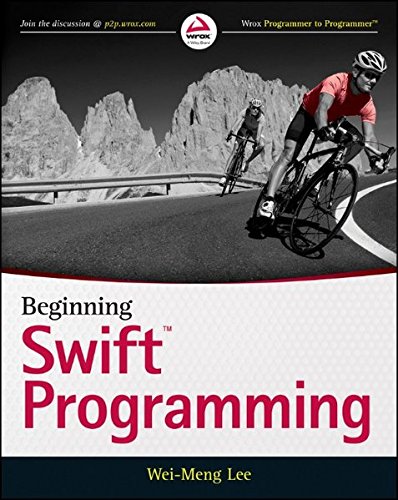

Most ebook files are in PDF format, so you can easily read them using various software such as Foxit Reader or directly on the Google Chrome browser.
Some ebook files are released by publishers in other formats such as .awz, .mobi, .epub, .fb2, etc. You may need to install specific software to read these formats on mobile/PC, such as Calibre.
Please read the tutorial at this link. https://ebooknice.com/page/post?id=faq
We offer FREE conversion to the popular formats you request; however, this may take some time. Therefore, right after payment, please email us, and we will try to provide the service as quickly as possible.
For some exceptional file formats or broken links (if any), please refrain from opening any disputes. Instead, email us first, and we will try to assist within a maximum of 6 hours.
EbookNice Team

Status:
Available0.0
0 reviews(Ebook) Beginning Swift Programming 1st Edition by Wei Meng Lee - Ebook PDF Instant Download/Delivery: 9781119009313 ,1119009316
Full download (Ebook) Beginning Swift Programming 1st Edition after payment

Product details:
ISBN 10: 1119009316
ISBN 13: 9781119009313
Author: Wei Meng Lee
(Ebook) Beginning Swift Programming 1st Edition Table of contents:
CHAPTER 1: INTRODUCTION TO SWIFT
What Is Swift?
Why Swift Is Important
Setting Up the Environment
Creating a Playground Project
Creating an iOS Project
Swift Syntax
Constants
Variables
String Interpolation: Including Values in Strings
Statements
Printing
Comments
Summary
CHAPTER 2: DATA TYPES
Basic Data Types
Integers
Types of Integers
Integer Operations
Integer Literals
Floating-Point Numbers
Floating-Point Operations
Floating-Point Literals
Type Alias
Boolean
Tuples
Optional Types
Implicitly Unwrapped Optionals
Optional Binding
Unwrapping Optionals Using “?”
Enumerations
Using Enumeration in Switch Statements
Enumeration Raw Values
Auto-Increment for Raw Values
Associated Values
Enumeration Functions
Summary
CHAPTER 3: STRINGS AND CHARACTERS
Strings
Mutability of Strings
Strings as Value Types
Characters
Concatenating Strings
Special Characters
Unicode
Common String Functions
Equality
Prefix and Suffix
Length
Substrings
Converting Strings to Arrays
Type Conversion
Interoperability with NSString
Casting String to NSString
Using NSString Directly
String or NSString?
Summary
CHAPTER 4: BASIC OPERATORS
Assignment Operator
Arithmetic Operators
Addition Operator
Subtraction Operator
Multiplication Operator
Division Operator
Modulus Operator
Increment and Decrement Operator
Compound Assignment Operators
Nil Coalescing Operator
Comparison Operators
Equal To and Not Equal To
Greater Than or Equal To
Less Than or Equal To
Range Operators
Logical Operators
NOT
AND
OR
Combining Logical Operators
Ternary Conditional Operator
Summary
CHAPTER 5: FUNCTIONS
Defi ning and Calling a Function
Input Parameters
Returning a Value
Returning Multiple Values
Function Parameter Names
External Parameter Names Shorthand
Default Parameter Values
Variadic (Variable) Parameters
Constant and Variable Parameters
In-Out Parameters
Function Types
Defining a Function Type Variable
Calling a Function Type Variable
Returning Function Type in a Function
Nested Functions
Summary
CHAPTER 6: COLLECTIONS
Arrays
Mutability of Arrays
Array Data Types
Retrieving Elements from an Array
Inserting Elements into an Array
Modifying Elements in an Array
Appending Elements to an Array
Checking the Size of an Array
Removing Elements from an Array
Iterating over an Array
Creating an Empty Array
Testing Arrays for Equality
Dictionaries
Mutability of Dictionaries
Retrieving Elements from a Dictionary
Checking the Size of a Dictionary
Modifying an Item in the Dictionary
Removing an Item from the Dictionary
Iterating over a Dictionary
Creating an Empty Dictionary
Testing Dictionaries for Equality
Copying the Behavior of Arrays and Dictionaries
Summary
CHAPTER 7: CONTROL FLOW AND LOOPING
Flow Control
If Statement
If-Else Statement
Switch Statement
Matching Numbers
Matching Characters
Fallthrough
Matching a Range of Numbers
Matching Tuples
Value Bindings
Where Clause
Looping
For-In Loop
Traditional For Loop
While Loop
Do-While Loop
Control Transfer Statements
Break Statement
Continue Statement
Labeled Statement
Summary
CHAPTER 8: STRUCTURES AND CLASSES
Structures
Memberwise Initializers
Structures as Value Types
Comparing Structures
Classes
Defining a Class
Properties
Stored Properties
Lazy Stored Properties
Computed Properties
Motivation Behind Computed Properties
The newValue keyword
Read-Only Computed Properties
Property Observers
Typed Properties
Initializers
Initializers and External Parameter Names
Initializing Variables and Constants During Initialization
Classes as Reference Types
Comparing Instances—Identity Operators
Comparing Instances—Equivalence Operators
Methods in Classes
Instance Methods
Local and External Parameter Names for Methods
The self Property
Type Methods
Methods in Structures
Summary
CHAPTER 9: INHERITANCE
Understanding Inheritance
Defining a Base Class
Instantiating a Base Class
Creating an Abstract Class
Inheriting from a Base Class
Overriding Initializers
Overloading Initializers
Creating Abstract Methods
Overloading Methods
Preventing Subclassing
Types of Initializers
Default Initializer
Designated Initializers
Convenience Initializers and Initializer Chaining
Calling Initializers in Subclasses
Extensions
Extending Methods
Extending Properties
Access Controls
Internal
Private
Public
Summary
CHAPTER 10: CLOSURES
Understanding Closures
Functions as Closures
Assigning Closures to Variables
Writing Closures Inline
Type Inference
Shorthand Argument Names
Operator Function
Trailing Closures
Using the Array’s Three Closure Functions
The map Function
Example 1
Example 2
The filter Function
Example 1
Example 2
The reduce Function
Example 1
Example 2
Using Closures in Your Functions
Summary
CHAPTER 11: PROTOCOLS AND DELEGATES
Understanding Protocols
Defining and Using a Protocol
Conforming to a Protocol
Optional Methods
Conforming to Multiple Protocols
Property Requirements
Initializer Requirements
Understanding Delegates
Delegates as Event Handlers
A Practical Example of Protocols and Delegates
Summary
CHAPTER 12: GENERICS
Understanding Generics
Using Generic Functions
Multiple Type Parameters
Specifying Type Constraint
Generic Types
Generic Classes
Generic Structures
Generic Type Extension
Using Generics in Protocols
Specifying Requirements for Associated Types
Summary
APPENDIX: EXERCISE ANSWERS
INDEX
People also search for (Ebook) Beginning Swift Programming 1st Edition:
swift beginner course
swift beginner
swift programming guide
learn swift beginner
learn swift programming for beginners
Tags: Wei Meng Lee, Swift Programming